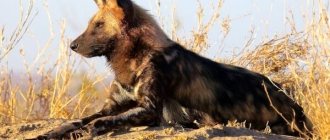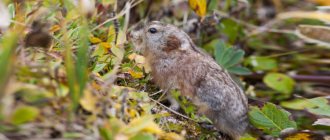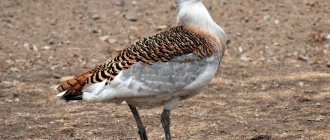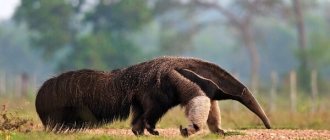There are about seven distinct species of wolves, and another seventeen (or so) varieties of gray wolf, making a total of about 24 species that can be found throughout the world.
The wolf is a typical predator that obtains food independently by actively searching for and pursuing victims. Everywhere, the basis of wolves' diet is ungulates: in the tundra - wild and domestic reindeer; in the forest zone - elk, roe deer, wild pigs, domestic sheep, cows, horses; near the steppe and desert - antelopes of various species and sheep; in the mountains there are wild and domestic goats.
Arctic (Polar) wolf
The polar wolf (Canis lupus tundrorum) is one of the rarest animals on our planet. The polar wolf's habitat is the Arctic. The wolf is well adapted to the harsh Arctic climate. Its thick, warm, windproof coat helps it survive in extreme temperatures. The wolf has keen eyesight and an excellent sense of smell, which are indispensable in hunting the small living creatures that inhabit these harsh places. Meager supplies of biological food and difficulties in obtaining food lead to the fact that the wolf eats its prey entirely, leaving neither the skin nor bones of the caught animals after the meal. Having an average weight of 60 to 80 kg and a height of up to 80 centimeters, the polar wolf is able to survive without food for several weeks in the event of an unsuccessful hunt, but then can eat up to 10 kilograms of meat at one time. Polar wolves live in packs of up to 10 individuals and hunt polar hares, reindeer and other animals. In one litter of a she-wolf, approximately 3 to 5 cubs are born. The unique fur of the polar wolf has always attracted increased attention from hunters, which has brought the polar wolf to the brink of extinction. Due to global warming and the melting of polar ice, the number of polar wolves continues to decline due to drastic changes in the climate of their usual habitats. Currently, the polar wolf is listed in the Red Book, and hunting it is prohibited.
Eye color
All wolves have blue eyes at birth. But by the 3rd month it changes to gold. Although there are exceptions when wolves spend their entire lives with blue eyes.
Look - Camel - description, habitats, diet, 130 photos and videos of the most popular camel species
Red Wolf
The red wolf is a rare species included in the IUCN Red Book and the Red Book of the Russian Federation. In Russia it is endangered. Hunting is allowed in India, but only with licenses. Externally, this animal has a peculiar appearance - the features of a gray wolf, fox and jackal are mixed. Body length 76-103 cm, tail – 40-48 cm, weight – 14-21 kg. The red wolf has thick, long, reddish-red fur on its back and sides, and on its chest, belly, and the inside of its legs, which are cream-colored. The long fluffy tail is similar to a fox's, it is darker than the rest of the body, almost black at the end. The head shows a dark pattern around the eyes and on the nose. The red wolf is a predator; it feeds mainly on wild animals, but in the summer it also consumes plant foods, namely mountain rhubarb. This plant is always found in dens with puppies. It is believed that wolves feed them to small wolf cubs, regurgitating half-digested rhubarb inflorescences. Sometimes they eat carrion. Wolves hunt in packs of 15-20 individuals and act very harmoniously, which allows them to catch even a large animal, for example, a buffalo. Thanks to their endurance, they drive their prey to exhaustion, after which its fate is sealed. Red wolves are quite talkative animals. Wakeful animals almost constantly emit a quiet whine, apparently maintaining communication with other members of the pack. In India, red caps reproduce within six months. The duration of pregnancy in females is 60-68 days. The average litter size is 4-6 puppies. The wolf cubs are dark brown in color, blind, weighing 200-350 g. The pups leave the hole at 70-80 days, and at seven months they already participate in collective hunting. Sexual maturity occurs at 2-3 years. Life expectancy in captivity is about 16 years. In captivity this period is much shorter.
Tasmanian marsupial wolf
The marsupial wolf, or thylacine , as it is otherwise known, is officially considered an extinct animal. According to official data, the last wild representative of this species was killed in 1930, and the last one kept in captivity in a private zoo died of old age in 1936. But there is still a possibility that the marsupial wolf still managed to survive in the wilderness of Tasmania (where it once thrived). But so far not a single animal has been caught or even photographed. But scientists do not lose hope. In 1999, scientists from the National Australian Museum, based in Sydney, issued a press statement announcing the start of an ambitious project to create a clone of the thylacine. The scientists intended to use the DNA of marsupial wolf pups that had been preserved in alcohol. DNA was extracted, but, alas, the samples turned out to be damaged and unsuitable for the experiment. The project was suspended. But in 2008, scientists managed to “revive” one of the marsupial wolf genes and “embed” it into a mouse embryo. So who is this marsupial wolf? The marsupial wolf (Tasmanian wolf or marsupial tiger) is a mammal, the only one in the thylacine family. Its first studies and descriptions date back to 1808. These descriptions were made by a certain Harris, he was an amateur naturalist. His work was published by the Linnean Society of London. The thylacine was one of the largest carnivorous marsupials in the world. The length of its body reached one and a half meters, and even more with its tail. Height at the withers is approximately sixty centimeters. The weight of the marsupial wolf was twenty to twenty-five kilograms. But the most amazing thing about his appearance was his mouth - elongated and elongated, it could open as much as 120 degrees. An interesting fact is known that when a wolf yawned, its jaws formed a straight line (well, almost a straight line).
We recommend: Quilted fabric on synthetic padding: which one to choose?
Dingo
Until now, biologists have not come to a consensus regarding the classification of dingoes. Some believe that the animal is a feral dog, in no way related to the wolf, while others believe that the dingo is a completely independent “wolf” species. One way or another, there is a version that he is a descendant of the Indian wolf, and a purebred one. Therefore, this animal is discussed in the article.
The species is widespread in Australia and Asia. Dingo is even found in New Guinea. It is a well-built, nocturnal predator with dense red fur. But the dingo also has white hair on its body (on the edge of the muzzle, tail and sternum). In New Guinea, there are also dark dingoes, with brown or even black fur.
Despite its "canine" nature, this type of animal never makes a sound reminiscent of a dog barking. But he howls by analogy with a wolf. This red animal settles near a pond. As a place to spend the night, dingoes choose large wooden hollows, holes or caves.
Interesting! Asian representatives of this species are not afraid of people, but, on the contrary, prefer to stay close to them. The fact is that people often feed dingoes. By the way, the red wolf-dog unites with its own kind, creating small groups. Only the leader and his female have the right to reproduce.
Maned wolf
The maned wolf (Chrysocyon brachyurus) or guar, aguarachay gets its name from the long hair that adorns its shoulders and neck, reminiscent of a horse's mane. The maned wolf's habitat is primarily the savannas of South America, but it can also be found in Brazil, Paraguay, Bolivia, Uruguay and Northern Argentina, where it lives in the pampas and along the edges of swamps overgrown with tall grass. Lean and light, the maned wolf has red fur, an elongated muzzle and large ears, which makes it look vaguely like a very large fox. The body length of the maned wolf, from the tip of the nose to the tip of the tail, is approximately 160 cm, the height of the wolf at the shoulders reaches, on average, 75 cm, and the weight varies from 20 to 23 kilograms. Aguarachai is the tallest-legged of all known wolf species. The long legs help the maned wolf locate prey over the tall grasses that cover savannas and wetlands. The wolf hunts, as a rule, alone, and its prey is mainly small animals, such as agouti, pacu, various birds and reptiles. The wolf also eats fruits and other plant foods, carries poultry, and is capable of attacking sheep when gathering in flocks. Auarachai live in pairs, but rarely contact each other. Maned wolf cubs have a black coat color and are born in winter, 2-3 cubs per litter. Aguarachai or maned wolves are listed as endangered on the International Red List of Threatened Species. Currently, there is no immediate threat of extinction, but the maned wolf still remains a very rare animal.
Melville Island wolf
The Melville Island wolf (Canis lupus arctos), also called the Ellesmere wolf or Arctic wolf, lives in North America on the Arctic island group and northern Greenland. The Melville Island wolf is slightly smaller in size than the common wolf, and its length, from ears to tip of tail, varies from 90 to 180 cm. The wolf reaches a maximum height of 69-79 cm, with a weight of about 45 kg, although especially large , adult males can weigh about 80 kg. The Melville Island wolf's fur is typically light white or grayish. A wolf's ears are small, which helps it efficiently expend heat in low temperatures. For more successful hunting, Melville wolves unite in packs of 5-10 individuals. The main objects of hunting for the Melville Island wolf are reindeer and musk oxen, to which the wolf pack uses driven hunting tactics, attacking mainly weakened prey that cannot offer strong resistance. The wolf's food also includes arctic hares, lemmings and, occasionally, moose. Permafrost is a significant obstacle that makes it difficult for a wolf to set up and dig a den, so wolves use the natural landscape and place their homes in rock ledges, caves or small depressions. The Melville Island wolf gives birth to few cubs, 2-3 cubs per litter, which is largely due to the harsh living conditions in the Arctic climate.
Common jackal
This small animal is also called “bark san”. The jackal is found in South Asia, however, not so long ago, it was widespread in some European countries, for example, in Albania. The jackal is very similar to a dog. It's smaller than, say, a dingo, or even a standard mongrel.
Its body weight is much less than that of the gray wolf, up to 20 kg. The jackal's muzzle is pointed and oblong, like a fox's. The fur of this "reduced wolf" is brownish-gray in color. In winter it becomes smoother. During the day, Kora San almost never eats, choosing to eat in the evening. He eats:
- Fish;
- Bird;
- Carrion;
- Snails;
- Frogs;
- Bugs;
- Berries;
- Snakes, etc.
It turns out that the jackal is practically omnivorous. He rarely hunts with his own kind. Despite its small size and lack of wolf endurance, a sharp mind and dexterity help the jackal to be a good hunter. It can silently sneak up on its prey and easily grab it before it can escape.
Japanese wolf
The Japanese wolf belongs to the class of mammals and the order of carnivores. The name Japanese wolf comes from two subspecies of the common wolf family (Canis lupus), which once lived on the islands of Japan. In the worldwide classification, the Japanese wolf belongs to the Hokkaido wolf (Canis lupus hattai). He is also known as Ezo, a wolf who lived on the island of Hokkaido. And the second subspecies is the Hondos wolf or Honshu wolf (Canis lupus hodophilax). Today, both species are considered extinct. In terms of external dimensions, Hokkaido was much larger than the Honshu wolf, and in terms of parameters it was approaching the size of an ordinary wolf. In 1889, this subspecies became extinct due to the increased settlement of the island for the construction of farms, during the Meiji restoration. The existing Meiji Government determined a reward for anyone who brings the head of a killed wolf, thereby organizing a campaign to exterminate them.
Character traits
The main feature of the Dutch Wolfspitz is its lack of aggression. These dogs are people-oriented. They are extroverts by temperament. They constantly need communication with their owner and family members. This dog feels uncomfortable where no one pays attention to it or caresses it. But she will become a devoted companion and favorite pet for an active owner. I am ready to support any games and activities, but will not be too intrusive. Keeshond senses the mood of its owner.
This is a rather emotional and cheerful dog. Therefore, he does not like conflicts and gets along well with any pets. Tries to create a positive atmosphere around him, loves to play pranks and make his owner laugh. He gets along well with children, is patient and affectionate, supports any games and can entertain a child.
The following character traits of the Keeshond can be noted:
- good nature;
- cheerfulness;
- sociability;
- curiosity;
- playfulness;
- devotion;
- agreeableness;
- peacefulness;
- stubbornness.
Education and training
Unlike the German Wolfspitz, which was bred as working dogs, the Dutch are more decorative. They are companions, not guards or watchmen. They need to be taught the necessary skills from an early age. Despite the fact that they are smart and quick-witted, it is important to find the right approach when training.
If you treat your dog with attention and love, it will quickly learn the rules of behavior. She immediately understands where to go to the toilet; you can accustom her to a tray or diaper. She is easily given basic commands from the General Training Course, various tricks, agility or freestyle.
During training, you need to take into account the characteristics of this breed:
- Keeshonds cannot be put under pressure and forced to do something if they do not want to;
- they cannot stand rude treatment, physical punishment, and are greatly offended;
- this is not a guard dog, it can bark to indicate that a stranger is approaching, but cannot show aggression;
- classes should be structured in the form of a game, they should be varied and interesting for the pet;
- training should be short but regular, preferably several times a day;
- the best reward for this dog is affection, praise, admiration; they do not like to work for treats;
- There is no need to scold the Spitz or shout at him; adult dogs understand intonation well.
Mackensen Wolf
Mackensen Wolf - Also known as the Mountain Wolf, Alaskan Wolf, or Canadian Forest Wolf. A direct relative of our timber wolf, but due to specific habitat conditions it has thicker fur and a whitish color that remains even in summer.
Tundra wolf, Central Russian forest wolf, Siberian forest wolf, Steppe wolf, Caucasian wolf, Mongolian wolf.
Central Russian forest wolf
Contrary to popular belief, it is this wolf that reaches its maximum size on the Eurasian continent, and not the tundra one. The coloring is classic, and not lightened, like the tundra. The body length of adult Central Russian forest wolves can exceed 160 cm, and the height at the shoulders can reach 1 meter. Of course, such dimensions can only apply to very large individuals. It is generally accepted that on average an adult male weighs 40 - 45 kg, a mature male (about 1 year and 8 months old) weighs about 35 kg, and a mature male (8 months old) weighs 25 kg. She-wolves weigh 15 - 20% less. Anyone who is familiar with old hunting literature, or who has been to “wolf” corners and talked with local residents, has probably read or heard about huge wolves. How much weight can wolves reach? For Central Russia, scientific works indicate a maximum weight in the range of 69 - 80 kg. (Ognev, Zvorykin). And here are the results of weighing specific animals. For the Moscow region - a male weighing 76 kg, the largest of the 250 wolves caught by the wolf hunter V.M. Hartuleri, famous in the thirties and forties of the last century. For Altai - a male weighing 72 kg. The wolf, stuffed of which is in the Moscow State University zoo museum, weighed 80 kg (5 pounds). According to N.D. Sysoev, the head of the state hunting inspection of the Vladimir region, in the period from 1951 to 1963, 641 wolves were killed, of which 17 were especially large. Among these animals, the largest weight was: of males - 79 kg, caught in the Sobinsky district, from females - 62 kg. The footprint of the right front paw of this huge, almost eighty-kilogram animal had a length of 16 and a width of 10 cm. It must be said that wolves of even larger sizes are indicated for Ukraine - 92 kg from the Lugansk region and 96 kg from the Chernigov region, but the conditions for determining the mass of these animals are unknown. The Central Russian forest wolf lives throughout the forest and forest-steppe zones of the European part of Russia, and probably penetrates into Western Siberia. In the north, it is quite possible for it to enter the forest-tundra, however, in the same way as the tundra into the taiga.
We recommend: You need to know the People's Artist in person! 
Interesting Facts
mushrooms,” but they also drank wolf blood and wore the skins of these animals.
Siberian timber wolf
It is also a large animal, not inferior in its average size to the previous subspecies. According to many scientists, it is still conditionally identified as a separate subspecies, since the taxonomy of Siberian wolves is still poorly developed. The predominant color is light gray, ocher tones are poorly visible or absent altogether. The fur, although not as tall and silky as that of the tundra wolf, is also thick and soft. Its habitat is largely considered to be Eastern Siberia, the Far East and Kamchatka, in addition to the tundra zone, as well as Transbaikalia.
Steppenwolf
In general, somewhat smaller than the forest one, with sparse and coarser hair. The color on the back is with a noticeable predominance of rusty-gray or even brown hair, and the sides are light gray. Its range includes the steppes of southern Russia, including the Cis-Caucasian, Caspian, Ural and Lower Volga regions. Poorly studied. A system of specific characteristics has not been developed. The number is low, especially in the western parts of the range.
Mongolian wolf
The Mongolian wolf is the smallest in size compared to all the wolves that live in Russia. The average weight of males of this species does not exceed 40 kg. The Mongolian wolf has a dull, dirty gray hue, coarse and coarse fur. This subspecies of wolves is common in the eastern and southwestern Transbaikalia and the Primorsky Territory.
Lifestyle of wolves. Migration of wolves in search of new territories
Click here to see hidden content
Video
And in conclusion, we invite you to watch an interesting film about wolves from the National Geographic channel - “The Rise of the Black Wolf.”
Author: Pavel Chaika, editor-in-chief of Poznavaika magazine
When writing the article, I tried to make it as interesting, useful and high-quality as possible. I would be grateful for any feedback and constructive criticism in the form of comments on the article. You can also write your wish/question/suggestion to my email [email protected] or Facebook, with respect, the author.
Author page
Lifestyle of wolves
Wolves are active mainly at night, but sometimes they can be found during the day.
They make their presence known by a vocal howl, which is very different in character among adult males, she-wolves and young ones, and also depending on the situation. The fact is that with the help of various kinds of howls, wolves exchange information about the presence of prey, the appearance of other wolves in the territory of the pack, the appearance of people and other important events. Wolves also have quite developed facial expressions - the expressions of their muzzle, posture and tail position can be very diverse, which reflects the emotional state of the animals and is of paramount importance for establishing contacts between individuals or, conversely, preventing collisions. Of the analyzers in wolves, the most developed is hearing, some weaker are vision and smell. Well-developed higher nervous activity in wolves is combined with strength, agility, tirelessness, running speed and other physical characteristics that significantly increase the chances of this predator in the fight for survival. Without visible effort, he can carry a sheep in his teeth, holding it in front of him or throwing it behind his back. If necessary, the wolf reaches speeds of up to 55-60 kilometers per hour, capable of traveling up to 60-80 km. per night, and on average per day (in the forest zone) to cover over 20 km. In the tundra, as well as in the mountains, wolves carry out seasonal migrations behind herds of wild and domestic ungulates. Sometimes there is a noticeable increase in the number of wolves in a certain area as a result of a sharp deterioration in living conditions in neighboring areas. Migration of wolves in search of new territories In a wolf pack there is a strict hierarchical ladder, which is determined by a very complex set of relationships in the pack, the age of its members and feats in hunting. The least respected are young wolves, who occupy the lowest places in the hierarchy; they are the ones who often fight off the pack, showing pride and impatience with oppression from their older brothers. Such wolves migrate from the territory occupied by the pack over quite long distances in search of the same tribesmen or smaller packs with weaker leaders and available lone wolves. Lone wolves move carefully, avoiding encounters with humans, but not necessarily at night. Along the way, the wolf stops to hunt, often for livestock. When meeting lonely brothers, they flock into small flocks and continue their journey in search of free territories and rich hunting grounds. In this case, a pack of migrating wolves can consist of up to three or five individuals. When united in a pack, wolves often attack shepherds and enter small villages, but only when they have no luck in the hunt for a long time. A meeting between migrating wolves and a pack of fellow tribesmen can result in trouble for a weaker enemy. Thus, going through difficulties and trials, wolves explore new territories, sometimes running hundreds of kilometers.
Click here to hide text
We recommend: Slot machines: review of online casinos
Wolf hunting. How wolves divide territory
Click here to see hidden content
Diseases of the Russian Wolfhund
The new breed is still too young to talk about systematic observations and conclusions about the heredity of these dogs. There is no reliable data on the average life expectancy of the Russian Wolfhund, but other Wolfhunds live a long time, up to fifteen to twenty years, so there is someone to take a good example from.
“Wild” wolf blood ensured good health for the Wolfhund
It is all the more important to select only genetically proven sires for further breeding work. The Alaskan Malamute is famous for its excellent health, and the infusion of “wild” wolf blood also worked to strengthen the immunity of the hybrid offspring. But there are no perfectly healthy animals, and the new breed also has some typical problems:
- hip dysplasia - in this case, the disease is more often provoked by poor quality breeding of a large dog;
- osteoarthritis - the result of abnormal growth of knee cartilage and bones;
- inflammation of the mucous membrane of the eyes;
- short-term bouts of vomiting or indigestion.
Dysplasia is the most dangerous disease in this series; it can have very serious consequences for the animal. The first manifestations of the disease become noticeable after four months. After lying down after sleep, the puppy suddenly begins to limp on one or both hind legs; then he walks around and the lameness disappears. But this is an alarming signal, and a visit to the veterinarian should not be postponed.
The problem develops as quickly as the puppy grows and gains weight - soon he will feel discomfort and pain in the joints, his hind legs will drag, or he will even lose the ability to move independently. The disease is diagnosed in the early stages using radiographic examination. Dysplasia is treated with medication or, in the most difficult cases, through surgery.
Wolf Hunt
Wolves belong to the canine family and are very similar to dogs in appearance and habits. Well-developed muscles and fairly long legs allow them to run quite quickly. Wolves used to be very numerous in the Northern Hemisphere, but they have been exterminated in many countries. Wolves live in packs according to the laws of hierarchy (one wolf dominates the others) and communicate using a whole range of sounds of different tones. How do wolves hunt? They move in search of prey along the same routes, more than 160 kilometers long. Sometimes it takes them several weeks to cover all the trails. Wolves are predators, so they eat meat. They attack other animals that they meet along the way. Wolves hunt deer, elk and other large ungulates. In Canada and Alaska, wolves follow on the heels of caribou herds, attacking young animals and weak, sick animals. In the north, wolves hunt musk oxen. And if they see a herd of livestock left unattended, they will immediately attack it. Wolves also hunt hares and other rodents, but only if there is no easier prey nearby. Hungry animals, having lost hope, will feast on fresh meat and are content with wild berries.
How wolves divide territory
Owning a huge territory, a pack of polar wolves, for example, will, of course, not be able to maintain exclusive rights to it, but wolves living in the forest, whose possessions are much smaller, are forced to clearly recognize the border of their territory. Wolves mark their possessions with the smell of their own body, raising their paws like domestic dogs. They do this especially carefully on the border with the territory of another pack. So that the neighbors understand who they are dealing with and are afraid to violate the border. Smells play an even greater role in communication between wolves than sounds. If one pack of wolves, for example, in the process of hunting, intersects with another, then a bloody showdown with the victims is inevitable, which is why the wolves howl, warning others of their location. Usually the alpha male begins to howl, his howl is picked up by others... When chasing prey, wolves howl, making shorter sounds, notifying their fellows where they are. All wolf packs nearby respond to the howl of one of the packs, and an unimaginable forest cacophony immediately begins. However, it often happens that one of the flocks does not reasonably pick up someone else’s howl, it is numerically too small, and therefore it needs to hide or retreat as quickly as possible for the same reasons. It should be noted that a lone wolf will never howl
Click here to hide text
Reproduction and raising of offspring
Sexual maturity in forest predators occurs when they reach 2 years of age. But, given the fact that wolves form long-lasting married couples, and at the same time choose a life partner for a long time, their first offspring appears no earlier than they are 3-4 years old.
Some wolves never become parents at all, because they could not find a suitable partner for themselves, and casual sex is not typical for them. Such lonely predators live on their own, or join some kind of pack, joining the ranks of warriors.
In wolves, the breeding season occurs only once a year and is strictly seasonal. Mating games of gray predators begin in January and last until March, so the birth of cubs occurs in favorable warm months, when the forests are full of game.
Features of the mating season
A peaceful and calm environment usually reigns in a wolf pack, but with the onset of mating season, tension increases in the clan of predators. The dominant pair fiercely protects each other from other family members and lone wolves. If there are already married couples in the pack, they also have to protect their partner from the attacks of their rivals. Well, predators who have not yet acquired their own pair are actively starting to search for their soul mate.
Couple of wolves in love
Wolves, on an intuitive level, avoid sexual relations with their close relatives, therefore individuals from the same brood never enter into a marriage union with their brothers and sisters. In most cases, young wolves generally look for a permanent partner among members of other packs.
There are many more males among wolves, so for one free she-wolf, from 2 to 5 suitors apply. An honorary escort of gray admirers gathers near young females and mature females (including widowed she-wolves), but not everyone has a chance to get a lady of their heart. Of course, males have to fight among themselves, and sometimes their fights are so fierce that they end in the death of one of the rivals. And what’s most interesting is that there is no guarantee that the winner will get the she-wolf. After all, the final decision remains with the female, and if she doesn’t like the gentleman, she won’t let him get close to her.
And when the knightly tournaments and brutal fights are over, wolf couples in love begin to look for a secluded place to be alone and find a safe lair for their heirs. From this moment until the birth itself, the male gallantly looks after his chosen one, not hesitating to express his feelings for her with affectionate touches and romantic “serenades”. As soon as the she-wolf becomes pregnant, the future father becomes even more caring and protects her from any threat. Well, the female responds to her husband with the same love, tenderness and devotion, and tries to spend all her free time with him, because after the babies are born, her attention will belong exclusively to the newborn wolf cubs.











